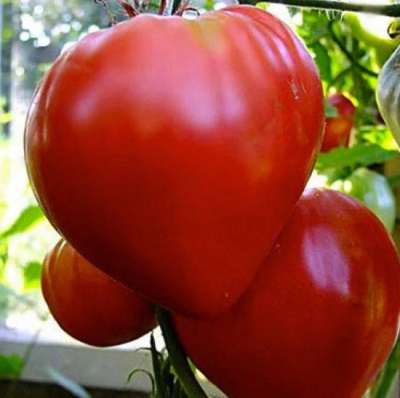
- Category: grade
- Growth type: indeterminate
- Appointment: fresh consumption, for canning in wedges, for juice
- Ripening period: late ripening
- Ripening time, days: 125-135
- Growing conditions: for open ground, for film greenhouses
- Bush size: medium-sized
- Bush height, cm: 140-170
- Foliage: small
- Ripe fruit color: Red
Without any exaggeration, one of the common favorite tomatoes can be called the Bull Heart Red variety. Indeterminate beef tomato with large, fleshy fruits is suitable for growing in film and polycarbonate greenhouses in all regions of the country, as well as in open ground in warm areas. Tomatoes are consumed fresh, in summer salads, assorted vegetables. In addition, good yields and the impossibility of whole-fruit canning allows you to use tasty fruits for cooking juices, sauces, lecho, tomato paste and winter salads.
Description of the variety
Medium-sized shrubs of small foliage give powerful shoots 140-170 cm high and above. Rare leaves of medium size, elongated shape are painted in an intense green color, close in tone to the palette of an old emerald. The leaf blade is covered with shallow but noticeable serrations, slightly pubescent. Small yellow flowers are collected in simple inflorescences and form clusters with 3-4 fruits. The first inflorescence is placed above 8-9 leaves, all subsequent ones after 2-3 leaf cuttings.
Red Bull Heart Benefits:
large-fruited;
excellent taste and decorativeness;
high yield and the possibility of cultivation in all regions.
Unfortunately, this excellent variety is not devoid of disadvantages - it is low immunity, a tendency to cracking, the need for pinching and tying.
The main qualities of the fruit
Large (150-400 g and above) fleshy cone-shaped fruits with a slightly elongated nose, shape, resemble a heart, due to which the variety received a similar name. These figures can be considered minimal, since good agricultural technology allows you to get fruits weighing 700, 800 and even 1200 grams. In this case, larger tomatoes are located on the lower tiers. The higher, the more modest the results, which is very reasonable - at the top of the shoots it is problematic to hold heavy brushes. Unripe green tomatoes at the stage of technical and physiological maturity acquire a red color with a rich scarlet hue.
Taste characteristics
The fleshy juicy pulp of a pleasant consistency has a balanced sweetness with a slight sourness, sugary at the break. The fruit section shows a small number of seed chambers with a limited number of seeds.
Ripening and fruiting
Bovine red heart belongs to late-ripening varieties, whose approximate ripening dates start from 125-135 days. Fruiting is quite extended, you can enjoy delicious fruits for quite a long time - from late July to almost September, although the peak falls in the first half of August.
Yield
The indicators make it possible to consider the tomato a high-yielding variety - up to 5 kg of large full-fledged fruits are removed from one bush, up to 15 kg from a square meter.
The timing of planting seedlings and planting in the ground
Seeds for seedlings are pretreated with special stimulants (Zircon, Epin-Extra, HB101), as well as a pink solution of potassium permanganate. This is usually done in February-March, planted in the ground two months later (late May - early June).

Growing tomato seedlings is an extremely important process, because it largely depends on whether the gardener will be able to harvest at all. All aspects must be taken into account, from seedbed preparation to planting in the ground.
Landing scheme
Correct agricultural technology requires planting plants according to the 40x60 scheme.

Growing and care
The red bovine heart is grown in the traditional seedling method. Seedlings are transplanted into greenhouses after 40-60 days. Into the open ground - after the threat of return frosts has passed. Tomatoes need good sunlight, high-quality supports or trellises, fertile soil with good aeration, and a neutral pH level. After planting, caring for the plants consists of watering, weeding, hilling or loosening. It is no less important to form a bush into one stem, therefore pinching is just as necessary as the organization of fertilizing and preventive treatments.




A plant needs different micronutrients at each stage of growth. All fertilizers can be divided into two groups: mineral and organic. Folk remedies are often used: iodine, yeast, bird droppings, eggshells.
It is important to observe the rate and period of feeding. This also applies to folk remedies and organic fertilizers.
Disease and pest resistance
The red bovine heart has an average strength of immunity, which means its tolerance to many diseases inherent in the crops of the nightshade group. Moreover, late ripening periods are due to a reduction in sunny days, an increase in humidity, nighttime cold snaps, and this is an excellent environment for the development of phytophthora. In order to prevent diseases and damage by pests, it is necessary to apply preventive treatments with insecticides and fungicides.


Resistant to adverse weather conditions
Tomato tolerates small temperature changes well. However, a severe cold snap or prolonged rains can be depressing, therefore cultivation in greenhouses is preferable.
Growing regions
Thanks to its positive qualities, the tomato has become the main soloist throughout Russia; gardeners grow it even in the Siberian regions, although more efforts are required from them to get handsome giants. In the southern regions and in the middle lane, it is, in general, an obligatory member of the tomato collections of self-respecting gardeners.

























































































